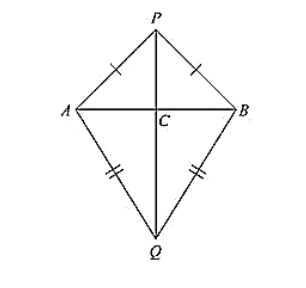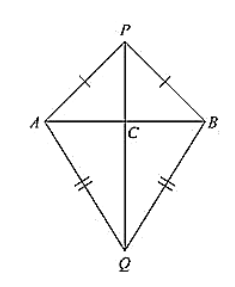AB is a line segment. P and Q are points on opposite sides of AB such that each of them is equidistant from
AB is a line segment. P and Q are points on opposite sides of AB such that each of them is equidistant from the points A and B (See Fig. (10).26). Show that the line PQ is perpendicular bisector of AB.

Consider the figure.
We have
AB is a line segment and P, Q are points on opposite sides of AB such that
AP = BP ... (i)
AQ = BQ ... (ii)
We have to prove that PQ is perpendicular bisector of AB.
Now consider ΔPAQ and ΔPBQ,
We have
AP = BP [From (i)]
AQ = BQ [From (ii)]
And PQ - PQ [Common site]
Δ PAQ ≃ Δ PBQ ... (iii) [From SAS congruence]
Now, we can observe that APB and ABQ are isosceles triangles. [From (i) and (ii)]
∠ PAB = ∠ ABQ and ∠ QAB = ∠ QBA
Now consider Δ PAC and Δ PBC
C is the point of intersection of AB and PQ
PA = PB [From (i)]
∠ APC = ∠ BPC [From (ii)]
PC = PC [common side]
So, from SAS congruency of triangle ΔPAC ≅ ΔPBC
AC = CB and ∠PCA = ∠PBC ... (iv) [Corresponding parts of congruent triangles are equal]
And also, ACB is line segment
∠ACP + ∠ BCP = 180°
∠ACP = ∠PCB
∠ACP = ∠PCB = 90°<
We have AC = CB ⟹ C is the midpoint of AB
From (iv) and (v)
We can conclude that PC is the perpendicular bisector of AB
Since C is a point on the line PQ, we can say that PQ is the perpendicular bisector of AB.

Click here to get exam-ready with eSaral
For making your preparation journey smoother of JEE, NEET and Class 8 to 10, grab our app now.
